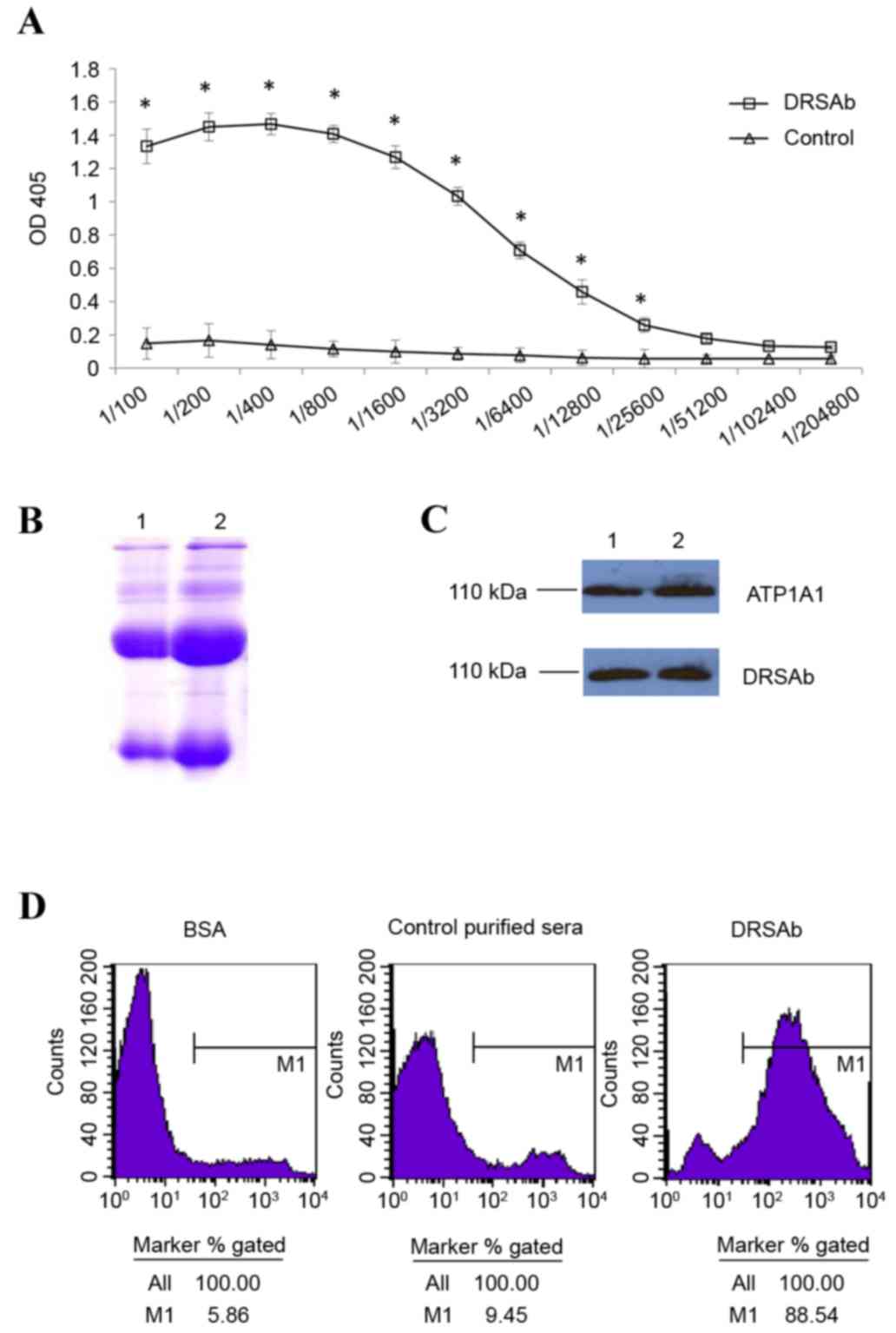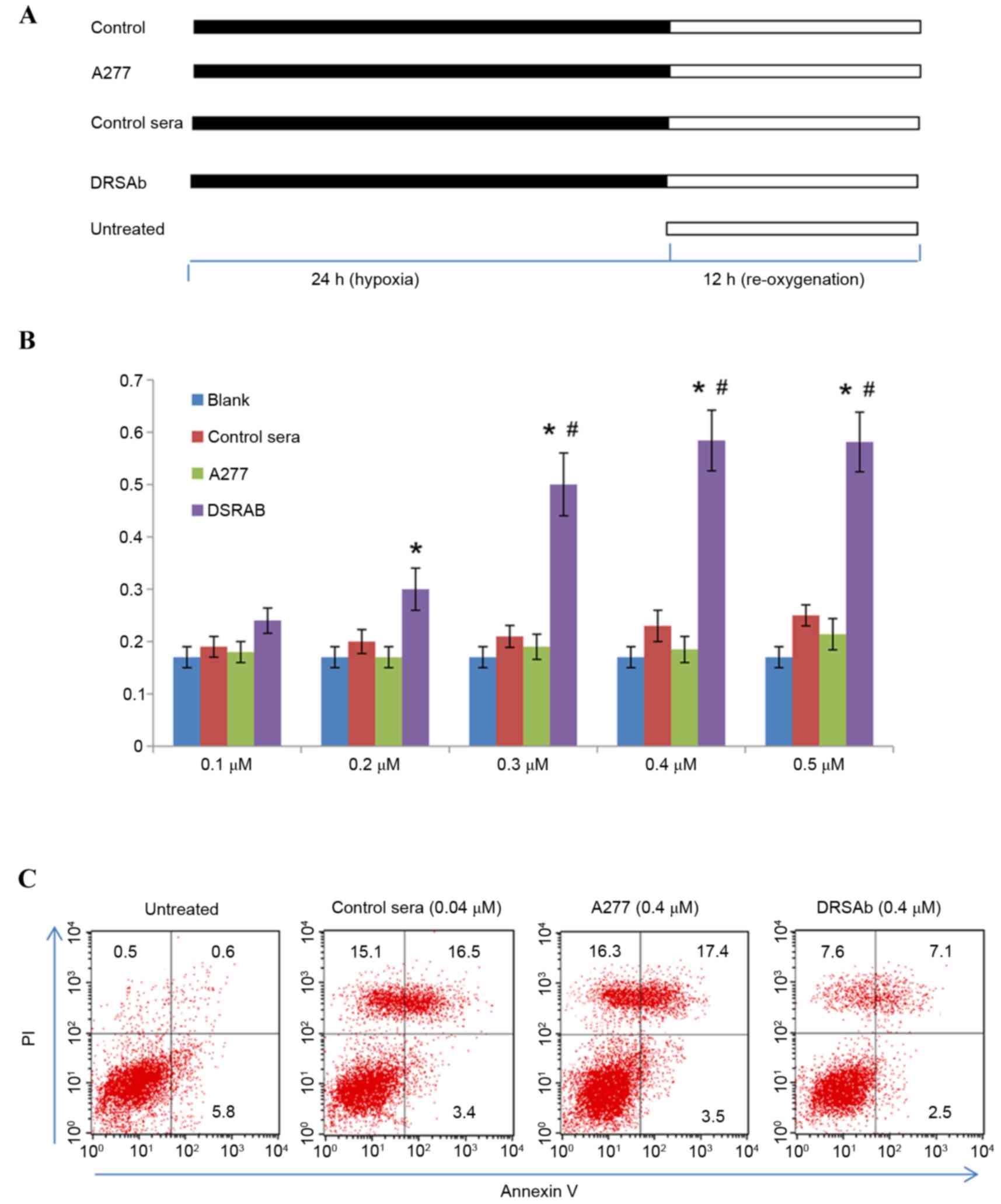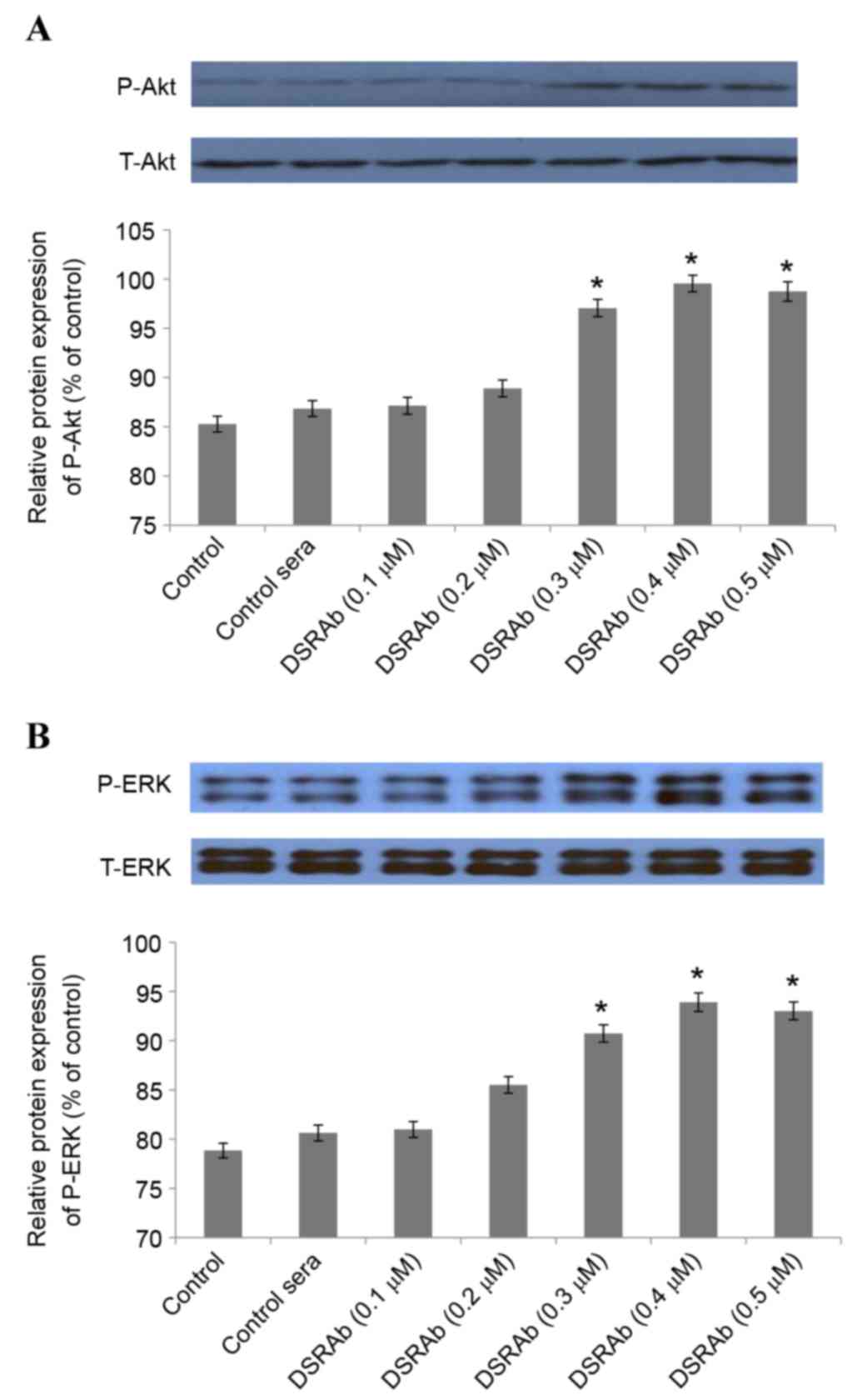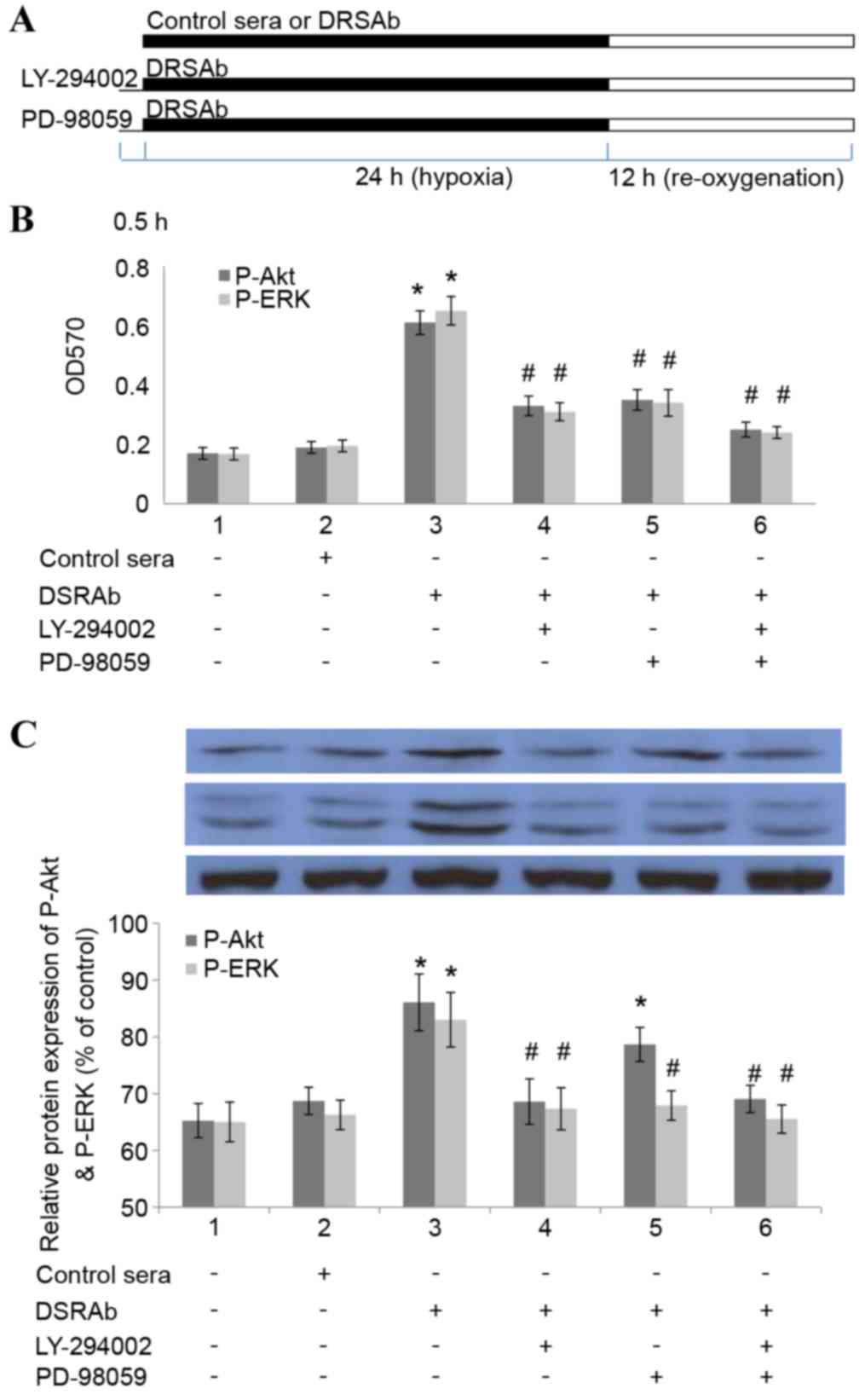Na+/K+‑ATPase DR region‑specific antibody protects U251 cells against hypoxia reperfusion‑induced injury via the PI3K/AKT and ERK pathways
- Authors:
- Published online on: September 26, 2017 https://doi.org/10.3892/mmr.2017.7622
- Pages: 7901-7906
-
Copyright: © Gong et al. This is an open access article distributed under the terms of Creative Commons Attribution License.
Abstract
Introduction
Cerebral ischemia is a condition in which there is insufficient blood flow to the brain to meet metabolic demand. This leads to poor oxygen supply or cerebral hypoxia and results in the death of brain tissue or cerebral infarction/ischemic stroke. Cerebral ischemia is a sub-type of stroke, as are subarachnoid and intracerebral hemorrhages. Ischemic stroke remains a leading contributor to mortality rates and long-term disability worldwide (1). In China, cerebral ischemia is a common cardiovascular disease and is the second most prevalent non-cancer-associated disease (2). The primary pathogenesis of cerebral ischemia includes an inflammatory response, edema, hypoxia and neuronal apoptosis, which result in several motor dysfunctions, including hemiplegia and paraplegia (3–5). It has been identified that the prognosis of cerebral ischemia is dependent on neuron survival and improvement in terms of neurological outcome (5). Accordingly, the development of innovative therapies to prevent neural damage caused by hypoxic-ischemic injury is a high priority.
The Na+/K+-ATPase (NKA) pump is an important plasma membrane protein, which comprises an α-subunit (100 kDa) and a b-subunit (55 kDa), and is situated on almost all animal cells. The primary function of NKA is the exchange of three sodium ions out of the cell for two potassium ions into the cell (6). Several studies have demonstrated that, in addition to the characteristic ion transportation, NKA can transfer extracellular binding signaling into the cell through the regulation of protein tyrosine phosphorylation (7–9).
A polyclonal antibody has been identified that targets the DR region (Asp 897-Arg 911) of the NKA a-subunit and stimulates NKA activity (10,11). The stimulation not only enhances heart contractility through the opening of L-type Ca2+ channels (12), but it also induces cardioprotective effects against hypoxia/reperfusion (H/R) injury through activation of the Src/phosphoinositide 3-kinase (PI3K)/AKT/extracellular-signal regulated kinase (ERK) 1/2 pathways (11).
ERK1/2 and PI3K/AKT are well-known pro-survival protein kinases important in cerebral H/R injury and have been reported to protect against transient focal cerebral H/R injury in rats by dexmedetomidine (13). The present study aimed to investigate the cerebral protective effect of the DR region-specific antibody (DRSAb) and its underlying mechanism in an H/R model of U251 cells.
Materials and methods
Animals
A total of 10 male Sprague-Dawley (SD) rats (250–300 g) were obtained from the Experimental Animal Center of Xi'an Jiaotong University (Xi'an, China) and housed in a standardized environment: Temperature 22°C, 50–60% humidity and 12:12 h light-dark cycle with access to laboratory rodent chow and tap water ad libitum under pathogen-free conditions in the Experimental Animal Center of Xi'an Jiaotong University (Xi'an, China). All protocols in the present study were approved by the Institutional Animal Care and Use Committees of Xi'an Jiaotong University.
Chemicals and reagents
The KLH-conjugated DR region peptide (897DVEDSYGQQWTYEQR911) was synthesized by GL Biochem, Ltd. (Shanghai, China). Rabbit anti-human NKAα1 subunit antibody (ATP1A1; L2C00601; 1:500), was produced by Jimianshiye (Shanghai, China), phosphorylated (P)-ERK1/2 (9106; 1:2,000), total (T)-ERK1/2 (9107; 1:1,000), P-AKT (4051; 1:1,000) and T-AKT antibodies (2920; 1:2,000) were purchased from Cell Signaling Technology, Inc. (Danvers, MA, USA). Goat anti-rabbit secondary antibodies (SC-2004; 1:10,000), goat anti-rat secondary antibodies (SC-2032; 1:10,000) and goat anti-mouse secondary antibodies (SC-2005; 1:10,000) were purchased from Santa Cruz Biotechnology, Inc. (Santa Cruz, CA, USA). LY-294002 (a PI3K inhibitor) and PD-98059 (an ERK1/2 inhibitor) were purchased from EMD Millipore (Billerica, MA, USA). Complete Freund's adjuvant (CFA), incomplete Freund's adjuvant (IFA), trypan blue dye and all other reagents used in the experiments were purchased from Sigma-Aldrich; Merck KGaA (Darmstadt, Germany). All chemicals were dissolved in distilled water with the exception of PD98059 and LY-294002, which were dissolved in dimethyl sulfoxide (DMSO) at a final concentration of 0.1% (w/v).
Preparation of DRSAb
The 10 adult male SD rats (6–8 weeks) were immunized with the KLH-conjugated DR region peptide (897DVEDSYGQQWTYEQR911) four times each week. The initial dose was 100 µg protein emulsified with CFA per rat followed by 50 µg protein emulsified with IFA per rat every week. At 5 days following the final immunization, the rats were anesthetized by intraperitoneal injection of pentobarbital sodium (50 mg/kg; Abbott Laboratories, North Chicago, IL, USA) and all blood was collected from the heart. The blood was incubated at 37°C for 30 min and then centrifuged at 5,000 × g for 20 min. The sera were stored at −80°C until use.
For antibody purification, a Protein L resin column was first balanced with 10× volume of phosphate buffer (pH 7.2) and the immune sera flowed automatically through the column. The unspecific protein was washed away using washing buffer. The antibody was eluted with 0.1 M glycine (pH 3.0) and the eluted fractions were immediately adjusted to physiologic pH by adding 100 µl of 1 M phosphate (pH 8.0) to 1 ml of the eluate. The elution was monitored by measuring the absorbance at 280 nm or by a protein assay (BCA™ Protein Assay kit; Thermo Fisher Scientific, Inc., Waltham, MA, USA).
To detect the titer of the immunized sera and purified antibody, a 96-well-plate was coated with DR region peptide at a concentration of 1 µg/well. The plate was blocked with 5% BSA for 1 h at room temperature following coating with the peptide at 4°C overnight. The immunized sera and purified antibody were diluted in a two-fold serial dilution and were then incubated with the coated DR peptides at room temperature for 2 h. The bound antibody was probed with goat anti-rat immunoglobulin G (IgG)-labeled with horseradish peroxidase (SC-2032; 1:10,000; Santa Cruz Biotechnology, Inc.) for 1 h at room temperature, followed by incubation with 3,3′,5,5′-tetramethylbenzidine for 15–30 min and reading of the optical density at 405 nm. The fractions of sera were stored at −80°C for future use.
Flow cytometric analyses
To analyze whether DRSAb was able to bind with the DR region of NKA in U251 cells, U251 cells (Cell Bank of the Chinese Academy of Sciences, Shanghai, China) were cultivated in Dulbecco's modified Eagle's medium (Gibco; Thermo Fisher Scientific, Inc.) supplemented with 10% (v/v) FBS, penicillin (100 mg/ml) and streptomycin (10 mg/ml) in a humidified incubator at 37°C with 5% CO2 for 48 h, and then harvested and divided into three samples, each containing 1×105 cells. The cells were incubated with purified DRSAb or control purified sera for 15 min at 37°C and then stained with the PE-conjugated anti-IgG heavy and light chain (H+L) antibody (BD Pharmingen, San Diego, CA, USA). The stained cells were run through a Becton Dickinson FACSCalibur flow cytometer (BD Biosciences, Franklin Lakes, NJ, USA) and the resulting data were analyzed using FlowJo software version 7.6 (Tree Star, Inc., Ashland, OR, USA).
H/R model of U251 cells
The U251 cells were randomly divided into three groups as follows: Control group, treatment group and untreated group. In the control group, the cells were seeded into 6-well plates (1×105), the culture medium was deprived of oxygen and glucose, and nitrogen-saturated D-hanks buffer solution was added, following which the culture plates were incubated for 24 h in a Tri Gas incubator (Heal Force Bio-meditech Holdings Ltd., Shanghai, China) with humidified air containing 5% CO2 and 94% N2 at 37°C to simulate hypoxia (~1% oxygen). Subsequently, complete medium was reintroduced and the culture plates were incubated in a normal culture incubator at 37°C for 12 h to simulate re-oxygenation (14). In the treatment group, all treatment procedures were the same as for H/R group; however, the cells were incubated with either control sera or different concentrations of DRSAb (0.1, 0.2, 0.3, 0.4 and 0.5 µM) during the administration of H/P. The cells in the untreated group were cultured in complete culture medium in a humidified air containing 5% CO2 at 37°C for 12 h without hypoxic exposure.
Measurement of cell viability
The U251 cells were plated at a density of 1×104 cells per well in 96-well plates and their viability was determined using a 3-(4,5-dimethyl thiazol-2-yl) −2,5-diphenyltetrazolium bromide (MTT) assay. The cells were treated with control purified sera or DRSAb at different concentrations and then subjected to H/R. Following H/R treatment, the cells were incubated with MTT solution (0.5 mg/ml final concentration) for 4 h at 37°C. The supernatant was then removed and the formazan crystals were dissolved in DMSO. The quantity of MTT formazan product was determined using a microplate reader (Tecan; Thermo Fisher Scientific, Inc.) at a wavelength of 560 nm.
Annexin-V/propidium iodide (PI) staining
To examine the effect of DRSAb on apoptosis, the U251 cells treated with H/R were stained with 25 µg/ml Annexin V-fluorescein isothiocyanate and 25 µg/ml PI. The staining was performed according to the manufacturer's protocol. The cells were analyzed using a flow cytometer (BD FACSCalibur; BD Biosciences). Data acquisition and analysis were performed using FlowJo software version 7.6 (Tree Star, Inc.).
SDS-PAGE and immunoblotting
SDS-PAGE and immunoblotting were performed as described previously (8). The U251 cells were scraped in radio-immunoprecipitation assay lysis buffer containing protease inhibitors. Subsequently, the extracted proteins concentration was determined using the bicinchoninic acid (BCA) protein assay kit (Thermo Fisher Scientific, Inc.) and separated on a 10% SDS-PAGE gel (10–30 mg). The fractionated proteins were then transferred onto a nitrocellulose membrane. Specific antigens were probed with corresponding monoclonal primary antibodies, as detailed above, at 4°C overnight, followed by incubation with the horseradish peroxidase-conjugated secondary antibody (1:10,000) at room temperature for 1 h. Immunoreactivity was detected using an ECL advanced western blot detection kit (GE Healthcare Life Sciences, Chalfont, UK).
Statistical analysis
Statistical analysis was performed using SPSS 17.0 software for Windows (SPSS, Inc., Chicago, IL, USA). All results are expressed as the mean ± standard deviation. One-way analysis of variance was used to determine the differences between each DRSAb concentration and control groups. P<0.05 was considered to indicate a statistically significant difference.
Results
Immunologic properties of DRSAb
The titer of DRSAb was first examined. As presented in Fig. 1A, the titer of immunized sera was significantly higher compared with that of normal sera between dilutions of 1:100 and 1:25,600 (Fig. 1A). This indicated that the sera obtained were enriched with DRSAb. The SDS-PAGE data revealed two distinct H+L chain bands of the purified antibody (Fig. 1B). DRSAb identified NKA in the U251 cells in addition to polyclonal rabbit anti human ATP1A1 (Fig. 1C). The binding of DRSAb to NKA was revealed using flow cytometry. High signals were detected on the U251 cells incubated with DRSAb, but not the control sera or BSA (Fig. 1D).
Effect of DRSAb on cell viability and apoptosis in H/P-treated U251 cells
The U251 cells were incubated with control sera, ATP1A1 or DRSAb at different concentrations (0.1, 0.2, 0.3, 0.4 and 0.5 µM, respectively), underwent hypoxia for 24 h and then re-oxygenation with complete medium in normal conditions for 12 h. The cells in the untreated group were cultured in complete culture medium in humidified air containing 5% CO2 at 37°C for 12 h without hypoxic treatment (Fig. 2A).
Treatment with H/R significantly decreased cell viability
DRSAb attenuated this effect at 0.3, 0.4 and 0.5 µM (Fig. 2B), however, it was not attenuated in the control sera or with ATP1A1, suggesting that DRSAb may have protected the cells against H/R-induced cell injury.
The present study also investigated the effect of DRSAb on the apoptosis of U251 cell following H/R treatment by performing Annexin V/PI staining. As presented in Fig. 2C, the data revealed that the administration of 0.4 µM DRSAb markedly reduced the number of apoptotic cells, whereas the numbers of apoptotic cells were markedly increased in the cell cultures treated with control sera or ATP1A1.
PI3K/AKT and ERK1/2 are involved in the protective effect of DRSAb
To investigate the involvement of PI3K/AKT and ERK1/2 in the protective effect of DRSAb, several experiments were performed. Western blot analysis demonstrated that the DRSAb-induced activation of PI3K/AKT and ERK1/2 increased depending on the concentration of DRSAb. Significant differences were identified at concentrations of 0.3, 0.4 and 0.5 µM (Fig. 3A and B).
In order to determine whether inhibiting the activation of PI3K/AKT and ERK1/2 eradicated the protective effect of DRSAb, the U251 cells were pre-incubated with LY-294002 (15 mM for 30 min), a selective AKT inhibitor, or PD98059 (30 µM; for 30 min), a selective pERK1/2 inhibitor, prior to treatment with DRSAb (Fig. 4A). It was identified that the two inhibitors eliminated the protective effects of DRSAb, which indicated that the protective effects were mediated via the PI3K/AKT and ERK1/2 pathways (Fig. 4B). It was also identified that LY294002 eliminated the phosphorylation of ERK1/2, whereas PD98059 did not alter the effect of DRSAb on the activation of AKT. These data suggested that PI3K/AKT was activated prior to the activation of ERK1/2 in the conditions in the present study (Fig. 4C).
Discussion
NKA is a plasma enzyme protein responsible for the active transport or pumping of Na+ and K+ ions across the plasma membrane. Previous studies have revealed that NKA has dual functions. In addition to pumping Na+ and K+ ions across cell membranes, it relays an extracellular ouabain signal to intracellular compartments via the activation of different protein kinases (15). The binding of ouabain to the signaling NKA activates the cytoplasmic tyrosine kinase, resulting in the phosphorylation of other proteins into different signaling modules. This, in turn, activates multiple protein kinase cascades, including mitogen-activated protein kinases (MAPK) and protein kinase C isozymes (16). It also increases the mitochondrial production of reactive oxygen species (17) and regulates intracellular calcium concentrations.
The extracellular DR region (897DVEDSYGQQ WTYEQR911) of the H7-H8 domain in the α-subunit is an important activation site of NKA, which is capable of promoting the catalytic function of the enzyme and regulating cardiac contractility (10). It has been previously reported that the activation of NKA with DRSAb produces protective effects via the PI3K/AKT and ERK pathways in the heart (11). It has also been reported that DRSAbs can statistically extend the survival of isolated cardiac myocytes and can protect cardiac myocytes against H/R injury by activating NKA and its subsequent signaling pathway (11). Therefore, the present study hypothesized that DRSAb may have the ability to induce a protective effect on U251 cells, similar to that elicited by the activator against the DR region. In the present study, a polyclonal antibody against the NKA DR region was constructed and it was identified that DRSAb was able to bind with U251 cells. Furthermore, it was identified that incubation with DRSAb produced protective effects in U251 cells and attenuated the appostosis induced by H/R.
The ERK signaling pathway is involved in the regulation of normal cell proliferation, survival, growth and differentiation (18). Studies have confirmed that the phosphorylation of ERK1/2 in cardiac myocytes and brain cells during early reperfusion serves as a protective mechanism against ischemic stress stimuli in the heart and brain (11,19).
In addition to ERK1/2, PI3K/AKT also serves as an important signaling pathway in effecting alterations in several cellular functions in response to extracellular signals (20). AKT, as a key downstream effector of PI3K, is activated in response to PI3K activation and regulates the activity of a number of targets, including kinases, transcription factors and other regulatory molecules, involved in the regulation of cell growth, proliferation and anti-apoptotic mechanisms (19,21,22).
In the present study, the involvement of the PI3K/AKT and ERK pathways in the DRSAb-induced protective effect on H/R injury was examined in U251 cells, as PI3K/AKT and ERK have been reported to be essential proliferative and survival molecules in different tissues (11,19,23). The present study examined the protective effect of DRSAb in the presence of LY-294002, a selective AKT inhibitor, or PD98059, a selective p42/44 MAPK inhibitor. LY-294002 and PD98059 successfully attenuated the protective effect induced by DRSAb, indicating that the protective effect of DRSAb was mediated by PI3K/AKT and ERK.
The signaling sequence of DRSAb was also examined. It was identified that the inhibition of PI3K/AKT by LY294002 attenuated the DRSAb-induced phosphorylation of ERK1/2. By contrast, the inhibition of ERK1/2 by PD98059 failed to attenuate the phosphorylation of PI3K/AKT. These data revealed that PI3K/AKT may be activated earlier than ERK1/2 in the conditions in the present study.
Taken together, the data obtained in the present study suggested that DRSAb provided cytoprotection in the H/R model through the PI3K/AKT and ERK signaling pathway.
The inhibition of PI3K/AKT and ERK contributed to the beneficial effects of DRSAb on U251 cell survival. These findings indicated that DRSAb produced important neuroprotective effects against neural injury, including ischemia in the brain. These findings suggested that there is potential for the development of DRSAb-based neuroprotectant therapies against neural damage from ischemia.
Acknowledgements
This study was supported by grants from the Natural Science Foundation of Shaanxi Province (grant no. 2015JM8392), the International Cooperation Project of Shaanxi Province (grant no. 2014KW21-01) and the National Natural Science Foundation of China (grant no. 3111100399).
References
|
Pendlebury ST and Rothwell PM: Prevalence, incidence, and factors associated with pre-stroke and post-stroke dementia: A systematic review and meta-analysis. Lancet Neurology. 8:1006–1018. 2009. View Article : Google Scholar : PubMed/NCBI | |
|
Chinese Society of Neurology, . Guidelines for the diagnosis and treatment of cerebral hemorrhage in China (2014). Chinese J Neurology. 48:435–444. 2015. | |
|
Gorelick PB: Stroke prevention therapy beyond antithrombotics: Unifying mechanisms in ischemic stroke pathogenesis and implications for therapy: An invited review. Stroke. 33:862–875. 2002. View Article : Google Scholar : PubMed/NCBI | |
|
Ma LL, Xing GP, Yu Y, Liang H, Yu TX, Zheng WH and Lai TB: Sulforaphane exerts neuroprotective effects via suppression of the inflammatory response in a rat model of focal cerebral ischemia. Int J Clin Exp Med. 8:17811–17817. 2015.PubMed/NCBI | |
|
Sherzai AZ and Elkind MS: Advances in stroke prevention. Ann N Y Acad Sci. 1338:1–15. 2015. View Article : Google Scholar : PubMed/NCBI | |
|
Kaplan JH: Biochemistry of Na,K-ATPase. Annu Rev Biochem. 71:511–535. 2002. View Article : Google Scholar : PubMed/NCBI | |
|
Liu J, Tian J, Haas M, Shapiro JI, Askari A and Xie Z: Ouabain interaction with cardiac Na+/K+-ATPase initiates signal cascades independent of changes in intracellular Na+ and Ca2+ concentrations. J Biol Chem. 275:27838–27844. 2000.PubMed/NCBI | |
|
Kominato R, Fujimoto S, Mukai E, Nakamura Y, Nabe K, Shimodahira M, Nishi Y, Funakoshi S, Seino Y and Inagaki N: Src activation generates reactive oxygen species and impairs metabolism-secretion coupling in diabetic Goto-Kakizaki and ouabain-treated rat pancreatic islets. Diabetologia. 51:1226–1235. 2008. View Article : Google Scholar : PubMed/NCBI | |
|
Wang Y, Zhan Y, Xu R, Shao R, Jiang J and Wang Z: Src mediates extracellular signal-regulated kinase 1/2 activation and autophagic cell death induced by cardiac glycosides in human non-small cell lung cancer cell lines. Mol Carcinog. 54 Suppl 1:E26–E34. 2015. View Article : Google Scholar : PubMed/NCBI | |
|
Xu KY: Activation of (Na+ + K+)-ATPase. Biochem Biophys Res Commun. 338:1669–1677. 2005. View Article : Google Scholar : PubMed/NCBI | |
|
Zheng J, Koh X, Hua F, Li G, Larrick JW and Bian JS: Cardioprotection induced by Na(+)/K(+)-ATPase activation involves extracellular signal-regulated kinase 1/2 and phosphoinositide 3-kinase/Akt pathway. Cardiovasc Res. 89:51–59. 2011. View Article : Google Scholar : PubMed/NCBI | |
|
Lee DI, Klein MG, Zhu W, Xiao RP, Gerzanich V and Xu KY: Activation of (Na++K+)-ATPase modulates cardiac L-type Ca2+ channel function. Mol Pharmacol. 75:774–781. 2009. View Article : Google Scholar : PubMed/NCBI | |
|
Zhu YM, Wang CC, Chen L, Qian LB, Ma LL, Yu J, Zhu MH, Wen CY, Yu LN and Yan M: Both PI3K/Akt and ERK1/2 pathways participate in the protection by dexmedetomidine against transient focal cerebral ischemia/reperfusion injury in rats. Brain Res. 1494:1–8. 2013. View Article : Google Scholar : PubMed/NCBI | |
|
Pan C, Prentice H, Price AL and Wu JY: Beneficial effect of taurine on hypoxia- and glutamate-induced endoplasmic reticulum stress pathways in primary neuronal culture. Amino Acids. 43:845–855. 2012. View Article : Google Scholar : PubMed/NCBI | |
|
Xie Z and Askari A: Na(+)/K(+)-ATPase as a signal transducer. Eur J Biochem. 269:2434–2439. 2002. View Article : Google Scholar : PubMed/NCBI | |
|
Mohammadi K, Kometiani P, Xie Z and Askari A: Role of protein kinase C in the signal pathways that link Na+/K+-ATPase to ERK1/2. J Biol Chem. 276:42050–42056. 2001. View Article : Google Scholar : PubMed/NCBI | |
|
Pasdois P, Quinlan CL, Rissa A, Tariosse L, Vinassa B, Costa AD, Pierre SV, Dos Santos P and Garlid KD: Ouabain protects rat hearts against ischemia-reperfusion injury via pathway involving src kinase, mitoKATP and ROS. Am J Physiol Heart Circ Physiol. 292:H1470–H1478. 2007. View Article : Google Scholar : PubMed/NCBI | |
|
Yue TL, Wang C, Gu JL, Ma XL, Kumar S, Lee JC, Feuerstein GZ, Thomas H, Maleeff B and Ohlstein EH: Inhibition of extracellular signal-regulated kinase enhances Ischemia/Reoxygenation-induced apoptosis in cultured cardiac myocytes and exaggerates reperfusion injury in isolated perfused heart. Circ Res. 86:692–699. 2000. View Article : Google Scholar : PubMed/NCBI | |
|
Yang Y, Zhang X, Cui H, Zhang C, Zhu C and Li L: Apelin-13 protects the brain against ischemia/reperfusion injury through activating PI3K/Akt and ERK1/2 signaling pathways. Neurosci Lett. 568:44–49. 2014. View Article : Google Scholar : PubMed/NCBI | |
|
Han XH, Cheng MN, Chen L, Fang H, Wang LJ, Li XT and Qu ZQ: 7,8-dihydroxyflavone protects PC12 cells against 6-hydroxydopamine-induced cell death through modulating PI3K/Akt and JNK pathways. Neurosci Lett. 581:85–88. 2014. View Article : Google Scholar : PubMed/NCBI | |
|
Hausenloy DJ and Yellon DM: Survival kinases in ischemic preconditioning and postconditioning. Cardiovasc Res. 70:240–253. 2006. View Article : Google Scholar : PubMed/NCBI | |
|
Lee SG, Su ZZ, Emdad L, Sarkar D, Franke TF and Fisher PB: Astrocyte elevated gene-1 activates cell survival pathways through PI3K-Akt signaling. Oncogene. 27:1114–1121. 2008. View Article : Google Scholar : PubMed/NCBI | |
|
Turjanski AG, Vaque JP and Gutkind JS: MAP kinases and the control of nuclear events. Oncogene. 26:3240–3253. 2007. View Article : Google Scholar : PubMed/NCBI |













